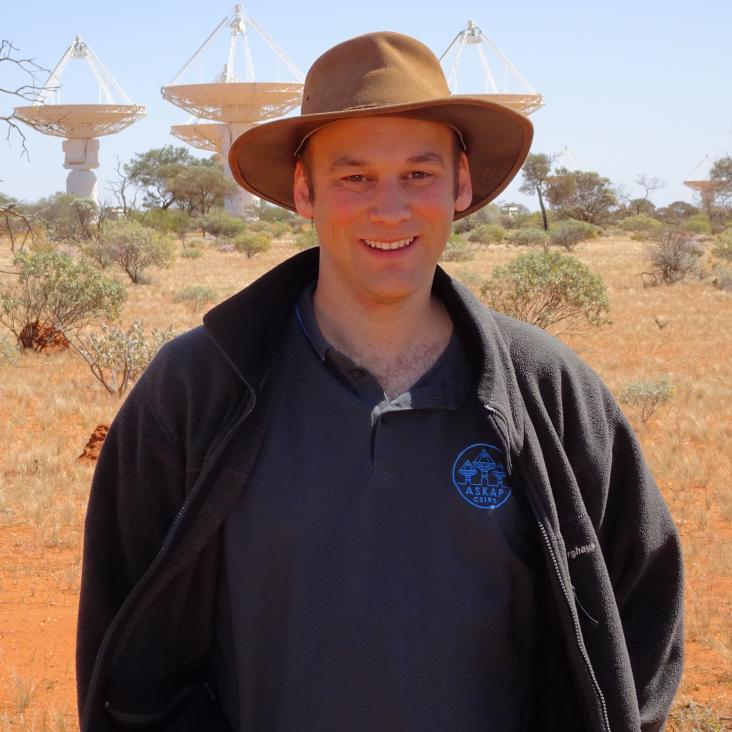Measuring the baryonic Tully-Fisher relation below the detection threshold
Monthly Notices of the Royal Astronomical Society Oxford University Press 508:2 (2021) 1897-1907
Abstract:
We present a novel 2D flux density model for observed H i emission lines combined with a Bayesian stacking technique to measure the baryonic Tully-Fisher relation below the nominal detection threshold. We simulate a galaxy catalogue, which includes H i lines described with either Gaussian or busy function profiles, and H i data cubes with a range of noise and survey areas similar to the MeerKAT International Giga-Hertz Tiered Extragalactic Exploration (MIGHTEE) survey. With prior knowledge of redshifts, stellar masses, and inclinations of spiral galaxies, we find that our model can reconstruct the input baryonic Tully-Fisher parameters (slope and zero-point) most accurately in a relatively broad redshift range from the local Universe to z = 0.3 for all the considered levels of noise and survey areas and up to z = 0.55 for a nominal noise of 90 μJy/channel over 5 deg2. Our model can also determine the MHI - M∗ relation for spiral galaxies beyond the local Universe and account for the detailed shape of the H I emission line, which is crucial for understanding the dynamics of spiral galaxies. Thus, we have developed a Bayesian stacking technique for measuring the baryonic Tully-Fisher relation for galaxies at low stellar and/or H I masses and/or those at high redshift, where the direct detection of H I requires prohibitive exposure times.COALAS: I. ATCA CO(1-0) survey and luminosity function in the Spiderweb protocluster at z=2.16
Astronomy and Astrophysics EDP Sciences 652 (2021) A11
Abstract:
We report a detailed CO(1-0) survey of a galaxy protocluster field at z = 2.16, based on 475 h of observations with the Australia Telescope Compact Array. We constructed a large mosaic of 13 individual pointings, covering an area of 21 arcmin2 and ±6500 km s-1 range in velocity. We obtained a robust sample of 46 CO(1-0) detections spanning z = 2.09 - 2.22, constituting the largest sample of molecular gas measurements in protoclusters to date. The CO emitters show an overdensity at z = 2.12 - 2.21, suggesting a galaxy super-protocluster or a protocluster connected to large-scale filaments of ∼120 cMpc in size. We find that 90% of CO emitters have distances >0.′5-4′ to the center galaxy, indicating that small area surveys would miss the majority of gas reservoirs in similar structures. Half of the CO emitters have velocities larger than escape velocities, which appears gravitationally unbound to the cluster core. These unbound sources are barely found within the R200 radius around the center, which is consistent with a picture in which the cluster core is collapsed while outer regions are still in formation. Compared to other protoclusters, this structure contains a relatively higher number of CO emitters with relatively narrow line widths and high luminosities, indicating galaxy mergers. We used these CO emitters to place the first constraint on the CO luminosity function and molecular gas density in an overdense environment. The amplitude of the CO luminosity function is 1.6 ± 0.5 orders of magnitude higher than that observed for field galaxy samples at z ∼ 2, and one order of magnitude higher than predictions for galaxy protoclusters from semi-analytical SHARK models. We derive a high molecular gas density of 0.6 - 1.3 × 109Mpdbl cMpc-3 for this structure, which is consistent with predictions for cold gas density of massive structures from hydro-dynamical DIANOGA simulations.Australian square kilometre array pathfinder: I. system description
Publications of the Astronomical Society of Australia Astronomical Society of Australia 38 (2021) e009
Abstract:
In this paper, we describe the system design and capabilities of the Australian Square Kilometre Array Pathfinder (ASKAP) radio telescope at the conclusion of its construction project and commencement of science operations. ASKAP is one of the first radio telescopes to deploy phased array feed (PAF) technology on a large scale, giving it an instantaneous field of view that covers 31 deg2 at 800 MHz. As a two-dimensional array of 36x12 m antennas, with baselines ranging from 22 m to 6 km, ASKAP also has excellent snapshot imaging capability and 10 arcsec resolution. This, combined with 288 MHz of instantaneous bandwidth and a unique third axis of rotation on each antenna, gives ASKAP the capability to create high dynamic range images of large sky areas very quickly. It is an excellent telescope for surveys between 700 and 1800 MHz and is expected to facilitate great advances in our understanding of galaxy formation, cosmology, and radio transients while opening new parameter space for discovery of the unknown.A statistical measurement of the H I spin temperature in DLAs at cosmological distances
Monthly Notices of the Royal Astronomical Society Oxford University Press 503:1 (2021) 985-996
Abstract:
Evolution of the cosmic star formation rate (SFR) and molecular gas mass density is expected to be matched by a similarly strong evolution of the fraction of atomic hydrogen (H I) in the cold neutral medium (CNM). We use results from a recent commissioning survey for intervening 21-cm absorbers with the Australian Square Kilometre Array Pathfinder (ASKAP) to construct a Bayesian statistical model of the NH I-weighted harmonic mean spin temperature (Ts) at redshifts between z = 0.37 and 1.0. We find that Ts ≤ 274 K with 95 per cent probability, suggesting that at these redshifts the typical H I gas in galaxies at equivalent DLA column densities may be colder than the Milky Way interstellar medium (Ts, MW ∼ 300 K). This result is consistent with an evolving CNM fraction that mirrors the molecular gas towards the SFR peak at z ∼ 2. We expect that future surveys for H I 21-cm absorption with the current SKA pathfinder telescopes will provide constraints on the CNM fraction that are an order of magnitude greater than presented here.The distribution and properties of DLAs at z ≤ 2 in the EAGLE simulations
Monthly Notices of the Royal Astronomical Society Oxford University Press 501:3 (2020) 4396-4419


